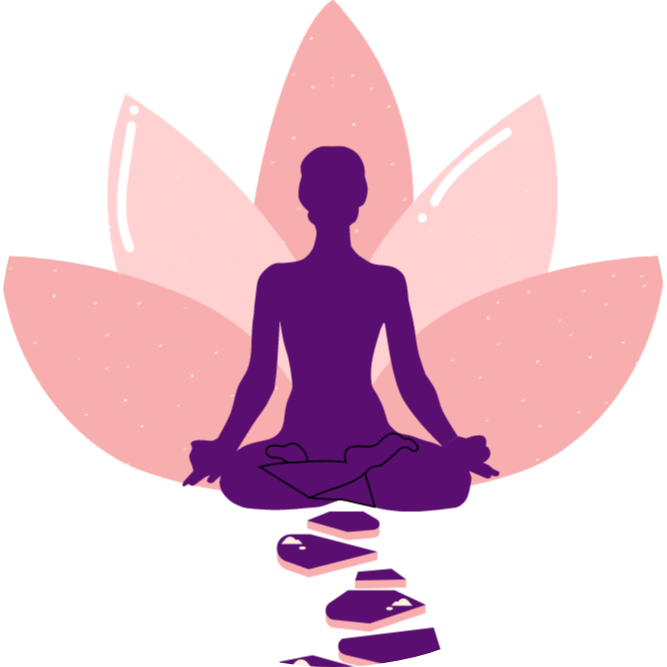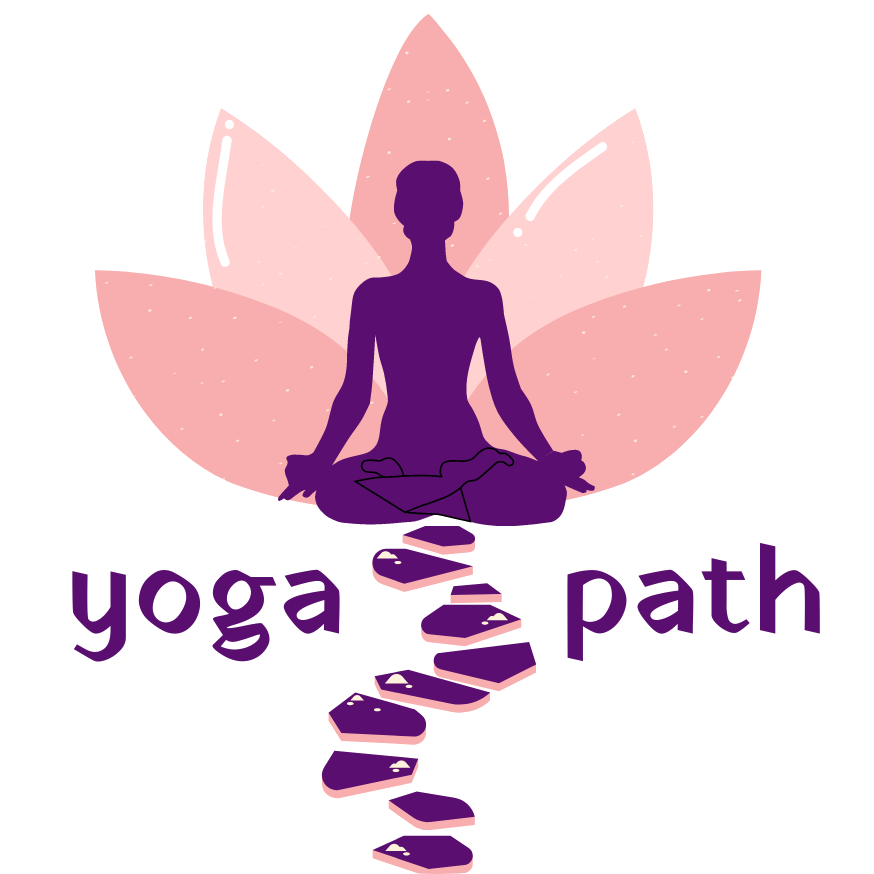Asanas for Hair Growth
ASANAS TO PROMOTE HAIR GROWTH
Yoga for strong and healthy hair
Yoga has many extensively wholesome health benefits. Yoga is also a way of life, and has been known to not just rejuvenate but heal mentally and physically. Along with this it is known to help maintain and strengthen skin and hair.
If you’ve looked everywhere for solutions to grow your tresses longer and thicker, don’t look further. There are several yoga asanas that can actually help out with hair growth. In fact, yoga has been popular for giving some wonderful results for a crowning glory.
Here are 9 yoga asanas that not just promote hair growth, but will also help in reducing hair fall and improving their health.
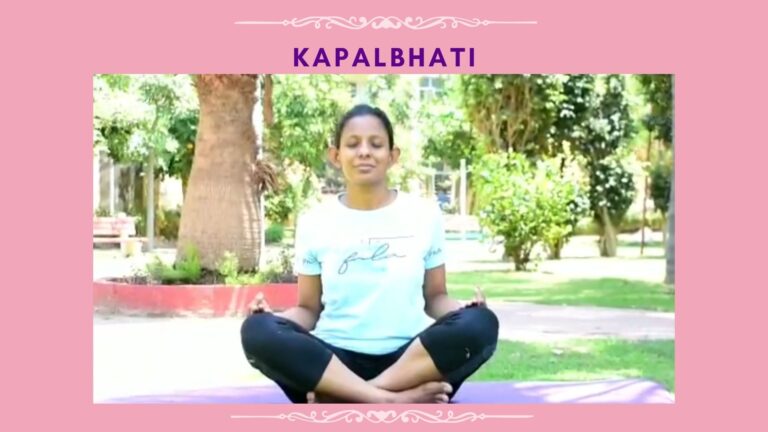
Precautions:
Kapalbhati pranayama revitalises and heals both the body and mind. This pranayama has deep powers to cure several ailments. But it must be practised with care:
If you are a beginner and are aged 40 or above, you must do it slowly with less repetitions 10-20 and they must be comfortably spaced out. Younger people can slowly increase the pace.
It is ideal to practice Kapalbhati early in the morning on an empty stomach.
Do not attempt Kapalbhati without learning how it is done. First get a health check-up done to ensure that you are fit enough to practice Kapalbhati. Then learn the technique from a certified yoga expert and practitioner.
Kapalbhati Pranayama
Kapalbhati is a Pranayam or breathing technique which involves active exhalation and passive inhalation’, Kapal means ‘skull’ and ‘Bhati’ means ‘Shining’ in Sanskrit and ‘Pranayam’ means ‘breathing exercise’. It also called breath of fire, is an important Shatkarma, a purification in hatha yoga.
It is mainly used for purifying the sinuses but according to the Gheranda Samhita has magical curative effects.
We begin in padmasana or sukhasana crosslegged, a posture where the spine is straight. With palms on knees facing upwards. Now inhale deeply and slowly through both nostrils filling up the lungs with air (focus on the abdomen expanding).
Then exhale through both nostrils forcefully with a hissing sound at the same time the abdomen forcefully pulls inward as the lungs deflate.
Follow this up with an automatic, immediate passive inhalation. Here you release your abdomen, and you will be able to feel your lungs filling up with air briefly.
Repeat the 20 times the rest for a few seconds.
Repeat another 20 times.
Contraindications:
Women should not practice during their menstruation cycle.
Pregnant women should also avoid doing Kapalbhati.Those with slipped disc should avoid Those suffering from heart diseases, must exhale really slow.
Patients of High Bp And epilepsy must avoid
Kapalbhati may aggravate ulcers and Hernia.
People suffering from respiratory problems like asthma, wheezing or bronchitis should be careful while doing the breathing exercises.
Before practising Kapalbhati, you should learn basic pranayama techniques and become proficient in them. This is because Kapalbhati is an advanced pranayama technique and trying this without proper knowledge can do more harm than good.
Benefits:
1. Kapalbhati benefits for the body:
Soothe your eyes and removes dark circles under your eyes.
De-stresses you and brightens your mind.
Gets rid of heartburn, acidity, and gas.
Increases the capacity of your lungs and makes them strong.
Alleviates sinusitis and improves blood circulation.
Aids in digestion and improves the metabolic rate of the body, thus helping in weight-loss.
Removes toxins and wastes from your body by generating heat and dissolving them.
Improves the functioning of your kidneys and liver.
Strengthens bones by causing an increase in your body’s calcium levels.
Potential to cure uterine fibroids.
Increases your body’s energy level.
Improves your immune system and your ability to fight disease-causing microbes. Slows down your body’s ageing process.
Helps cure insomnia.
Can regularise women’s menstrual cycles and prevent menstrual cramps.
Kapalbhati has numerous health benefits and can remedy various ailments.:
The benefits for Kapalbhati for diabetes by lowering of blood sugar and by stimulating the pancreas to produce sufficient insulin and also by reduction of stress, which is a contributing factor to erratic blood sugar levels.
The benefits of Kapalbhati for weight loss include toning abdominal muscles, and increasing core abdominal strength. Kapalbhati thus helps in fighting obesity.
It can also provide relief from constipation and relief from related disease
It can treat varicose veins.
2. Kapalbhati benefits for Brain/Mind:
Stimulates the nerves, energise the brain, and calm the mind.
Prevents depression and boosts production of endorphins, making you feel positive.
Provides with a sense of balance.
Improves your memory and help you concentrate better.
3. Benefits for Skin
Can prevent and give relief from acne
Helps in eliminating toxins from the body and slow ageing.
Helps clear clogged skin pores, hence clarifying the skin and giving your face a luminous glow.
4. Benefits for Hair
Arrests hair loss and prevents premature greying of hair.
Kapalbhati Pranayama is rapidly becoming well-known as the yoga technique to alleviate numerous ailments and bestow excellent physical and mental health. It is simple, easy to learn, and does not require too much time or any equipment to practice. So go ahead and try Kapalbhati Pranayama for your physical and mental well-being. Make sure you check with both your doctor and your yoga teacher before starting Kapalbhati if you have any health conditions.
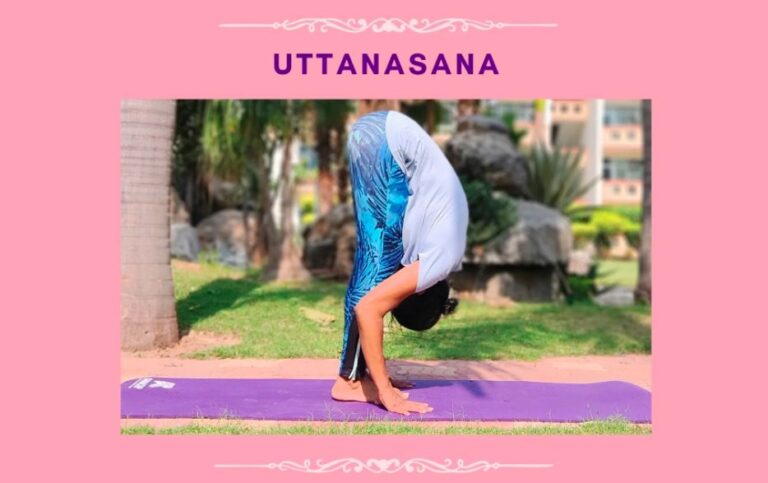
Standing Inverted Position – Forward Bend
This asana flows with humility and acceptance of the self along with surrender to the universe. It represents a cycle of energy generated within the body and offered to the universe.
- Stand with your feet together and hands at the side.
While inhaling, raise both your hands from the front above your head. - While exhaling, bring the your hands down to touch your toes or grasp your ankles keeping your knees straight.
- Remember to keep your ears and hands together as a unit as you bend down or rise up.
- Keeping your knees straight, try to touch your forehead to the knees. Stay in the position for 6 seconds breathing normally – extend to 2 minutes.
- While inhaling, raise your hands up above your head and exhaling bring your arms down to the sides.
Contraindications:
Hypertension, Cardiac ailments, Pregnancy, Peptic ulcers, Hernia, Back or Spinal Injuries, Cervical spondylitis, Slipped disc and serious Eye disorders such as glaucoma and myopia.
Benefits:
Results in extreme stretching of back and leg muscles
Brings flexibility to your spine
Increases the blood circulation to refresh your nervous system. It also calms your mind and prevents migraines.
Abdominal compression provides good circulation and massage to abdomen and pelvic organs
Tones the abdominal wall and reduces unnecessary fat deposits in the abdominal area
Induces clavicular breathing and aids proper ventilation of the uppermost part of the lungs
Stimulates the nervous system and endocrine system
Improves blood circulation
Aids sleep
Adho Mukha Svanasana – Inversion Asana
Adho meaning down, mukho meaning Face, svana meaning Dog. This asana too is part of the flow of surya namasakar (salute to the sun).
The name is derived from the way the dog stretches his front limbs when getting up.
In this pose, we can start by sitting on all fours in a table top position with knees and palms on the floor. The palms are at shoulder distance on the floor also the knees and feet are at hip distance apart. Lift the knees up to raise the hips up as you inhale. The weight of the body is on both palms and feet. With both arms straight at the elbows and the legs being straight at the knees the hips are raised up the head is down with arms close to the ears. We try to press the chest into the thighs just as we try to close a book to make a V shape. As you exhale, lower down the knees, hips and back into table top.
Contraindications:
Pregnant women, high blood pressure, Weak eye capillaries,
detached retina, or any other infection or inflammation of the eyes and ears and shoulder or back injury
Benefits:
Stretches the hamstring and calf muscles
Strengthens arms and shoulders, legs and ankles
Relaxes and strengthens back muscle
Strengthens abdominal muscles and core
Improves posture
And calms the heart
Vajrasana – Seated Asana
Vajrasana Asana meaning Thunder Bolt Pose. This yoga posture has been named after the shape it takes – that of a diamond or thunderbolt. One can sit in Vajrasana at the time of doing pranayamas.
Assume a kneeling position on a mat with your knees touching each other. Let your toes touch each other and the heels remain apart. Lower your body and sit comfortably in the space between your toes and heels. Place your hands upon your knees with your palms facing downwards.
Close your eyes and passively observe your breath or keep your gaze fixed at one point. Sit for around 5 to 10 minutes.
Contraindications:
Acute arthritis and very high or low blood pressure.
Benefits:
It stretches the thighs, calves, ankles and hips.
It stretches the spine, corrects postural defects.
It improves blood circulation to the abdominal region thus helping improve digestion
Alleviates sciatica or severe lower back problems or constipation or stomach disorder or digestive problems or acidity
Hence with improved digestion and assimilation hairfall is greatly reduced
Flexibility of the lower limbs
The generative organs are toned
It provides relief from urinary problems.
This posture calms the mind and relaxes the nerves.
If you want to put pressure on Surya Nadi allow the left toe to rest on the right toe
If you want to put pressure on Chandra Nadi allow the right toe to rest on the left toe
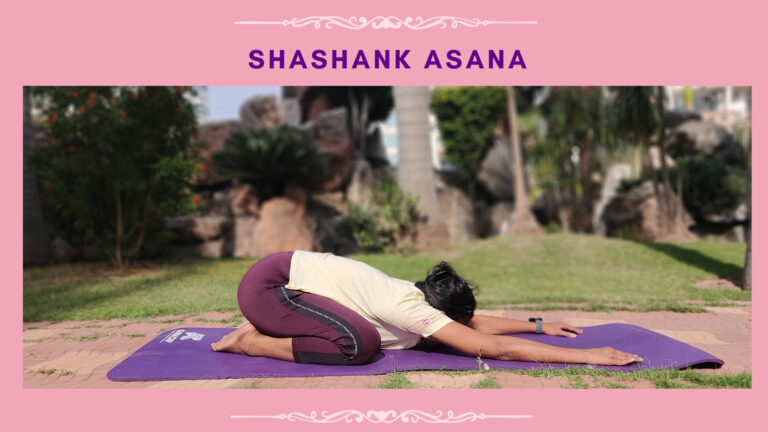
Shashank Asana – Prone Position Forward Bend
Shashank Asana meaning Hare Pose
Shashank Asana is a great way to release tension from your upper body and open up your shoulders, back, and spine, which can increase blood flow to your head. When the forehead is rested on the ground, many pressure points are activated, which can relieve migraines and headaches.
- In this asana, sit in Vajrasana resting the palms on the thighs. Spread the knees out.
- Inhale and raise the arms above the head. Elbows must be straight, maintain shoulder width apart distance between the arms.
- Exhale and slowly bend the torso forward and place forehead palms, elbows and arms stretched out in front between the knees on the floor.
- Bend from the pelvic region. The hips should remain touching the heels. Retain the position as long as comfortable. It could be practiced from a minute to 5 minutes.
- To go back in the base position, exhale and slowly lift the forehead, arms above head. Lower the arms resting the palms on the thighs. Relax and take deep breaths.
Contraindications:
Vertigo, high blood pressure, knee problems or slipped disc.
Pregnant women should refrain from practising this asana.
Benefits:
Massages the abdominal organs, muscles and organs of the pelvic region.
Improves digestion and alleviates constipation.
Relaxes the spine and all muscles of back.
Improves functioning of adrenal glands.
Stretches back muscles and strengthens it.
Enhances the health of reproductive organs.
Relaxes sciatica nerve.
Improves blood supply to the head and therefore nourishes the eyes and all brain functions.
Helps to relieve fatigue and promotes concentration.
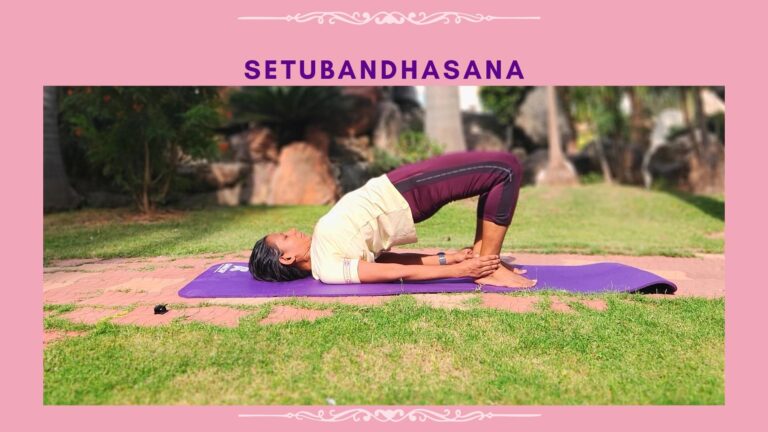
Sethubandhasana – Supine Asana
Setu meaning Bridge; Bandha meaning Bind or Lock.
A major trigger for migraines can be holding tension in the shoulders and neck. Sethubandasana relaxes your upper body and can increase blood to your brain as your heart is lifted above your head.
- To begin, lie on your back. Fold your knees and keep your feet hip distance apart on the floor, close to your pelvis, with knees and ankles in a straight line.
- Place your palms on your ankles. Inhaling, slowly lift your lower back, middle back and upper back off the floor; gently roll the shoulders inwards; raise the chest to the chin supporting your weight with your shoulders, arms and feet.
- Both the thighs are parallel to each other and to the floor. Hold this pose for few breaths. exhale as you gently release the pose.
Contraindications:
Neck injuries, Shoulder or back injuries or surgery, Hypertension, Heart ailments, Myopia and Glaucoma or retinal detachment.
Benefits:
Strengthens the back muscles
Relaxes back instantaneously
Gives a good stretch to the chest, neck and spine
Opens up the lungs and reduces thyroid problems
Strengthens glutes and quadriceps
Calms the brain, reducing anxiety, stress and depression
Helps improve digestion
Helps relieve the symptoms of menopause and menstrual pain
Helpful in asthma, high blood pressure, osteoporosis, and sinusitis
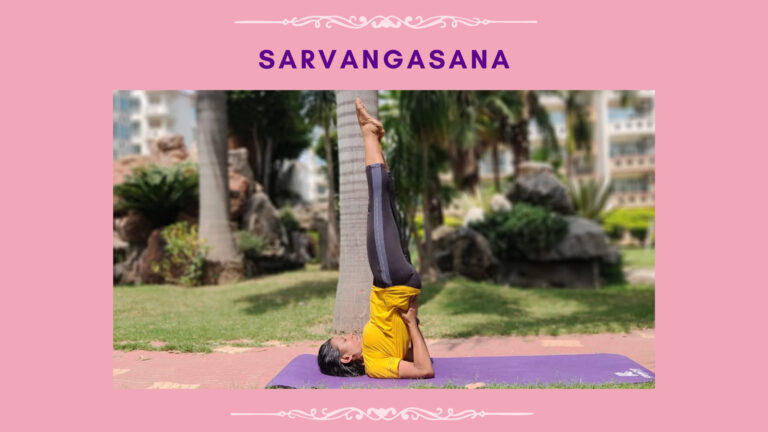
Sarvangasana – Inversion Pose
‘Sarva Anga’ – means full body. It is beneficial for all the systems of the body, especially the head that houses the brain.
Lie supine on a mat with your feet together and hands at the sides. While exhaling, raise your legs up together, toes to point towards the ceiling. Keep knees straight. Use your hands to support your body at the back the chin is set against the chest.
Maintain this pose for a few seconds or as long as convenient but not longer than two minutes, the breathing slow, rhythmic and natural.
Slowly bend your knees, then, as you inhale, lower your hips towards the mat, releasing your hands from back, lower the legs slowly without jerking the head.
Take a few deep breaths.
Precautions To Be Taken during Performance of This Asana:
Avoid any possible extreme strain. It is best to attempt this asana first in stages and attempt this asana only after a few weeks of preparation.
What needs emphasis is the fact that this pose should never be attempted after any form of rigorous Exercises because the rush of blood to the brain at this stage might do more harm than good. Place importance on the position and comfort of the neck.
Contraindications:
Hypertension, cardiac ailments, Pregnancy, Respiratory disorders, Cervical spondylosis, spinal problems, neck injuries or trauma, High myopia, glaucoma, serious eye disorders.
Benefits:
Physical
It strengthens your arms and shoulders.
It keeps your spine flexible.
It nourishes your brain with more blood.
It improves the functioning of your thyroid, parathyroid, and pituitary glands.
There are favourable changes in vasomotor ability due to the increased interchange of blood in the upper part of the body, especially the thorax, the neck, and the head.
Relief from congestion, through the rapid drainage of venous blood, in the abdominal and pelvic regions.
There is a good healing effect of gravity on the various organs of your body above the waist, including the endocrine glands.
It helps alleviate varicose veins.
It is helpful in constipation, dyspepsia, headache, giddiness, neurasthenia, functional disorders of the eye, the ear, the nose and the throat, general and sexual debility. It helps alleviate piles and fissures.
This is one of the most effective asanas for the increase of blood flow towards your brain., it not only impacts the whole body it makes your mind alert giving a feeling of self-confidence and self-reliance.
Psychological
It relieves stress as it calms your brain and nervous system.
It helps to balance the moods and calms your mind.
It increases your confidence.
Muscles Involved:
Trunk flexors and wrist extensors.
Flexors and extensors of the lower limbs.
Extensors of the neck and erector spinae.
Isometric contraction of the hip and knee.
Matsyasana
Supine Pose – Lying down with backward bending
Matsya Asana meaning the Fish pose.
In this asana, lie on your back, with feet together and hands relaxed alongside the body. Place the hands underneath the hips, palms facing down. Bring the elbows closer toward each other.
Inhaling lift the head and chest up.
Keep the chest raised and expanded, lower the head backward and touch the top (crown) of the head to the floor, placing the weight on the elbow.
Press the legs to the floor. Hold the pose for 6 seconds to 1 minute. Relax and breathe deeply.
Lift the head up, lower the chest and head to the floor. Bring the hands back along the sides of the body. Relax.
Contraindications:
High or low blood pressure, Migraine and insomnia, serious lower-back or Neck injuries.
Benefits:
Stretches the chest and neck.
Helps relieve tension in the neck and shoulders.
Expands lungs and improves respiratory system.
Tones the parathyroid, pituitary and pineal glands.
Heals reproductive disorders.
Shavasana
Supine Position – Relaxation Pose
Shava meaning Corpse.
This pose gets its name from the reclined posture of a dead body. It is a position of rest, relaxation, and rejuvenation is usually practiced towards the end of a yoga session.
- Lie flat on your back and close your eyes. Keep your legs at a comfortable distance apart and relaxed and toes facing to the sides. Place your arms a little spread apart from your body. Leave your palms open, facing upward.
- Taking your attention to different body parts one by one, slowly relax your entire body.
- Begin with bringing your awareness to the right foot, move on to the right knee (in the same way you complete one leg, and move your focus to the other leg), and so on, and slowly move upwards to your head, relaxing each part of the body.
- Keep breathing slowly, gently, deeply and allow your breath to relax you deeper. The incoming breath heals the body while the outgoing breath relaxes. Make sure you don’t fall asleep!
After some time, about 5-20minutes when you feel fully relaxed, keeping your eyes closed, slowly roll onto your right side. Lie in that position for a few seconds or so. Then, with your eyes still closed, sit up into cross legged pose (Sukhasana) taking the support of your right hand. Take a few deep breaths in and out.
When you feel completely in touch with your surroundings, slowly and gently open your eyes.
Benefits:
Deep, meditative state of rest, which helps in the repair of tissues and cells
Releases stress
Helps rejuvenation
Reduces blood pressure, anxiety, and insomnia.
This is an excellent way to ground the body and reduce the Vata dosha (imbalance of the air element) in the body.
